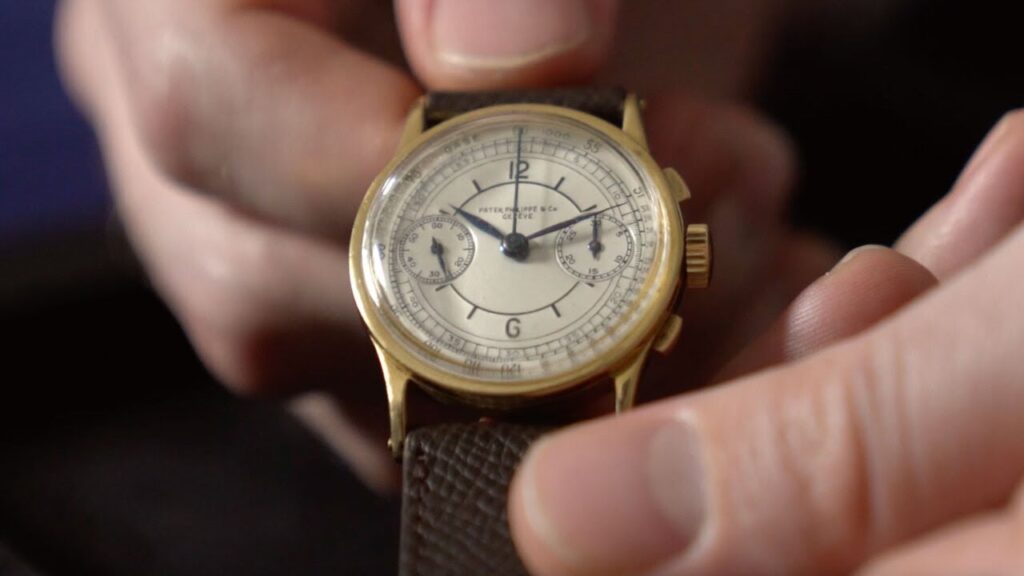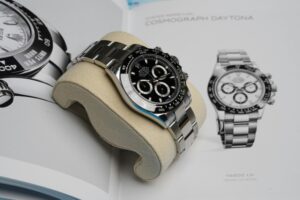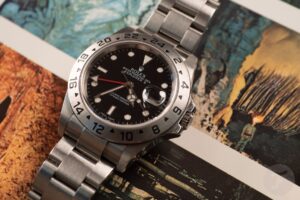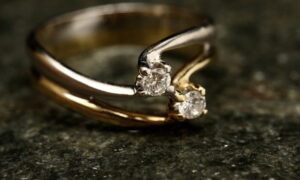What role does the watch’s provenance play in its resale value?

The recent record-shattering sale of a Paul Newman Daytona highlighted the importance of provenance in vintage watches. Whether owned by celebrities, a member of a royal family, or another noteworthy person, a story behind the watch drives its resale value.
Brands with a strong heritage, like Rolex and Patek Philippe, tend to maintain their values better than others. Also important is ensuring the watch has all its original parts and has been regularly serviced.
Brand Recognition
Brand recognition is a key concept in business, defined as the degree to which a consumer can identify a product based on its logo, tagline, colors, or other features. When a brand has high recognition, consumers are more likely to remember it and prefer it over similar products that they have not tried.
This phenomenon has been observed in the watch market, with certain brands gaining a cult following for their unique designs, limited production runs, and high quality construction that are reflected in their resale value. Independent watchmakers such as MB&F, F.P. Journe, and Richard Mille have achieved this recognition by combining innovation with a rich heritage to create watches that set them apart from the rest of the market.
Brand recognition can also be built through the use of marketing strategies, including advertising, partnerships/collaborations, and even product placement. For example, Rolex’s association with celebrities, athletes, and influential figures contributes to its resale value by reinforcing the image of its watches as symbols of success and achievement. In addition, its history of horological excellence and strong customer service have positioned it as a safe investment option.
While a watch’s country of origin has some influence on its perceived quality, it is not as important as the brand’s reputation for craftsmanship and innovative design. A good example is the Swiss brand Frederique Constant, which has earned a solid reputation for its classically designed watches powered by in-house movements for reasonable prices.
A watch’s resale value can be significantly impacted by its brand recognition, regardless of its price range. For example, a watch from a company with a poor reputation for quality will likely not have as high of a resale value as one from a reputable manufacturer like Omega. This is because consumers are more likely to have a positive perception of a brand with a strong reputation, regardless of whether it’s expensive or not. This is why it’s important for a watch to have a clear identity that sets it apart from other competitors. This is especially true for luxury watches, which need to be distinctive enough to be recognized and remembered by consumers.
Condition
Whether you’re a watch collector or just looking to sell your own, the condition of a pre-owned watch plays an important role in determining its resale value. A well-maintained and pristine watch will retain its value much longer than a poorly maintained or worn watch.
In addition to a watch’s overall condition, the specific details will impact its value. For example, a dial in exceptional condition will add more to the overall value of a watch than one that is less than perfect. Similarly, a case in pristine condition will have more resale value than one that is scratched or damaged.
The material a watch is made of also plays a major factor in its resale value. Watches made from precious metals like gold and platinum typically have more resale value than watches that are made from stainless steel or other less expensive materials. Watches with rare embellishments, such as diamonds, may also have greater resale value.
The age of a watch can also have an impact on its resale value. Certain brands, such as Rolex, Patek Philippe, and Audemars Piguet, are renowned for their durability and timelessness, which can help them retain or even increase their value over the years. Watches with vintage appeal can also be highly sought-after, resulting in higher prices.
Functional condition also plays a key role in resale value. For instance, a watch with a fully functioning movement will have more resale value compared to a watch that has lost its ability to function.
When it comes to assessing the functional condition of a watch, an experienced horologist can provide a professional and accurate assessment. This includes capturing high-resolution photos of the watch from multiple angles, documenting the service history, and assigning a final grade based on objective criteria and expert judgment.
Another important factor to consider when determining the resale value of a watch is its original documentation. This includes the original box, papers, and any additional accessories that may have been included with the watch when it was purchased new. In addition, a well-documented service history will be beneficial to the resale value of horologically significant models like Rolexes.
Rarity
Rarity has a reputation for being particularly meticulous and precise, which can make her a bit of a control-freak when it comes to the way she treats her friends. However, she is not afraid to get her hooves dirty if it means helping others or creatures in need. In fact, she once cut off her own tail to calm down a sea serpent in Friendship Is Magic, part 2, proving that beauty is only skin deep when it comes to true compassion.
Older watches, especially vintage models with an interesting history, typically command a premium price on the resale market. These watches may have a specific design or function that makes them stand out from other models, such as a slide rule bezel that was used for navigation-related calculations or an unusual color scheme. They may also have a particular historical significance, such as being made during the Quartz Crisis or having been worn by military personnel during World War II.
Another factor that contributes to the resale value of an older watch is its condition. A well-maintained, pristine watch in excellent condition is always preferred to one that has been poorly looked after. This is especially true for high-end luxury watches, where the quality of components like the dial and case can significantly influence the overall value.
It is also important to keep in mind that the resale value of a vintage watch can often fluctuate based on broader economic trends. For example, during periods of economic prosperity, luxury watches tend to see an increase in demand, which can lead to higher prices. It is therefore essential to monitor news and updates about the watch industry to stay up-to-date on current market trends.
In addition to the factors mentioned above, a watch’s provenance can also play a significant role in its resale value. Provenance is the name given to a watch’s story, including its history and its connection to a person or place. A watch with a strong, compelling provenance will likely attract more interest from potential buyers and sellers. The history of a watch can be discovered by researching its serial number or by examining its condition and documentation.
Provenance
A watch’s provenance can play an outsized role in its resale value. Provenance is the history of ownership, including records of maintenance and instances of repair, which are important aspects of assessing a vintage watch’s condition. A watch with a strong provenance is like a well-documented historical artifact – it adds layers of intrigue and credibility that make it more appealing to collectors.
A good example of this is the Patek Philippe Ref 2499 in platinum owned by Eric Clapton, which sold at auction last year for CHF3.4 million. The watch was in excellent condition, but the fact that it was previously owned by a rock legend is what pushed it to such a high price.
In addition, a watch with a strong provenance can help weed out counterfeit watches, which have become a serious issue in the luxury market. Counterfeits are often made to look like genuine watches, but they lack the markings and engravings that can prove a watch’s authenticity.
The word provenance has a different meaning in the world of archaeology and art history, where it describes the set of circumstances under which a work came to light. It’s derived from the French word “provenir” which means to come forth, and it refers to documentation recording authorship and ownership, as well as the place where the piece was found.
For museum curators and art historians, provenance is an essential part of evaluating an artwork’s authenticity. It also helps explains how a painting was created and used in society, which provides clues as to its meaning and significance.
However, some collectors will only buy a watch with impeccable provenance. For example, some collectors only purchase’safe queens’ – watches that have spent the majority of their lives in safes and are therefore in near-mint condition with very few signs of wear. This is because they view the provenance of a watch as proof of its authenticity and quality.
A robust provenance can also make a collector feel more confident in purchasing a watch, as it shows that the seller has taken care of the timepiece and that it has been properly maintained and repaired over its lifetime. This is especially important when buying a vintage watch from a private or estate sale, where the background of the seller may be less clear.





